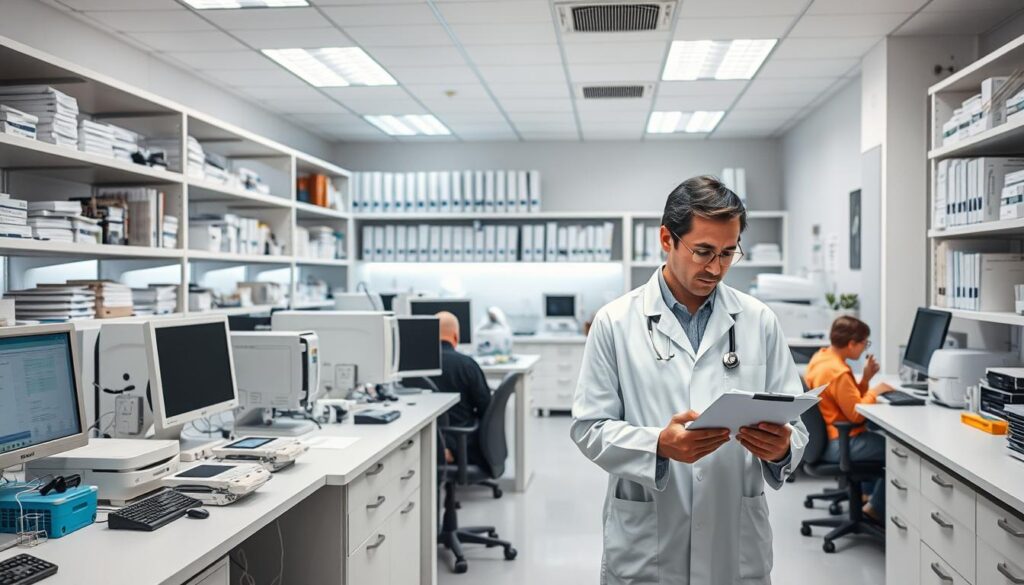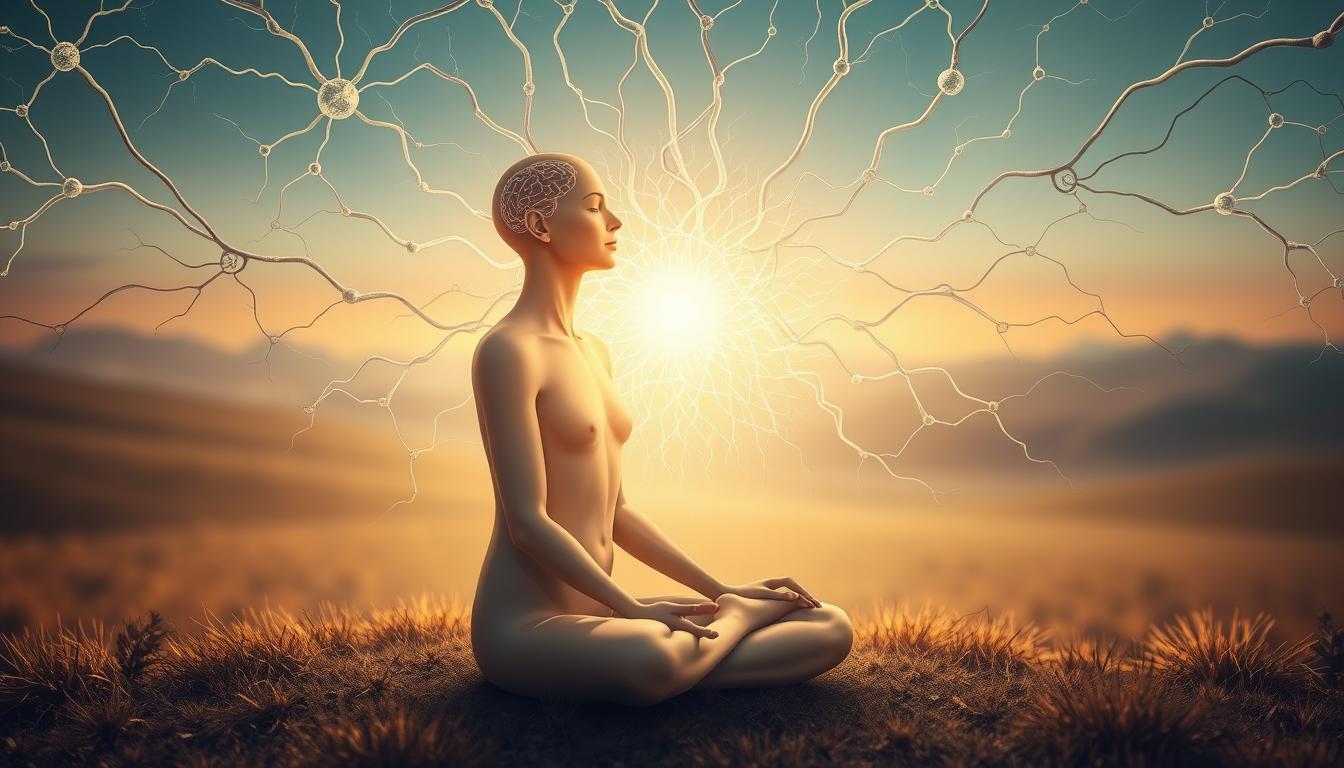Imagine a group of children with severe allergies participating in a study. Researchers told them one arm was brushed with a harmless leaf, while the other touched a “poisonous” plant. In reality, both arms were exposed to the same harmless substance. Yet, nearly every child broke out in rashes only on the arm they believed was “safe”. Their brains had written a physical reaction based purely on expectation.
This isn’t magic—it’s your neural wiring at work. Modern research reveals that what you think is happening can be as powerful as medical treatment. When patients receive sugar pills believing they’re medicine, their brains often release natural painkillers like endorphins. Some studies show these responses can mirror prescription drugs’ effects, particularly in pain management and depression.
Neuroscientists now map how anticipation activates specific brain regions. A caring doctor’s reassurance or even the color of a pill bottle becomes part of your body’s healing equation. This discovery changes everything: Your mind isn’t just observing your health—it’s actively shaping it.
Key Takeaways
- Expectation triggers measurable physical responses through natural brain chemicals
- Medical environments and provider interactions amplify healing signals
- Context shapes pain perception more than previously understood
- 72% of participants in some trials experienced relief without active treatment
- Your beliefs activate the same neural pathways as pharmaceutical interventions
The Mind-Body Connection Behind Placebo Effects
Your brain constantly translates thoughts into physical reactions. Neuroscience research shows that external cues—like a doctor’s white coat—and internal beliefs activate neural pathways linked to healing. In one striking trial, patients given sham acupuncture for IBS reported 63% pain reduction simply because clinicians projected confidence.

This mind-body interplay stems from classical conditioning. Just as Pavlov’s dogs salivated at a bell, your nervous system learns to associate specific stimuli with relief. Runners who believed they’d consumed caffeine completed 12% more sprints—despite receiving none. Their brains had wired effort to expectation.
Advanced neuroimaging reveals these expectations activate the prefrontal cortex and nucleus accumbens. These regions govern reward processing and decision-making, proving perceived treatment effectiveness isn’t just psychological—it’s biological.
“Your beliefs don’t just comfort you—they rewire neural circuits that control pain and inflammation.”
Your mental state directly influences immune responses. Positive expectations boost infection-fighting cells by 14% while lowering inflammatory markers. Every thought you have about treatment becomes part of your body’s healing toolkit.
Placebo Effects in Clinical Trials and Research
What if a sugar pill could rival prescription drugs? Clinical trials prove it can. After World War II, researchers discovered that 35% of patients improved using inactive treatments when they believed they were receiving medicine. This revelation transformed how studies evaluate new therapies.

Modern trials use double-blind designs to separate biological effects from belief. In these studies, neither you nor the scientists know who receives real treatment. A landmark analysis showed that initial success rates for depression medications dropped by 50% when tested against sugar pills under these controlled conditions.
“The most powerful ingredient in any treatment might be the patient’s conviction it works.”
Consider this comparison of trial designs:
| Study Type | Participant Knowledge | Result Difference |
|---|---|---|
| Open-Label | Know treatment identity | +42% perceived benefit |
| Double-Blind | Unaware of group assignment | Accurate efficacy data |
Your brain’s response plays a measurable role. When participants expect relief, neural networks release natural painkillers—even without active drugs. This explains why some migraine studies show equal improvement across treatment and control groups.
placebo effect explained – Unleashing Your Brain’s Healing Potential
Consider a scenario where belief alone triggers your body’s repair systems. In a groundbreaking trial, patients with knee arthritis experienced identical improvements whether they received real surgery or a simulated procedure. Their brains interpreted the medical ritual as permission to activate natural repair mechanisms.
Your nervous system releases its own pharmacy of relief when convinced help has arrived. One man’s chronic headaches vanished after taking vitamin C pills he believed were migraine drugs. Scans later showed his brain had flooded with pain-blocking chemicals—mirroring prescription medication’s effects.
How does this work? Positive expectations act like keys unlocking neural pathways. A study of 180 participants revealed that confidence in treatment tripled the release of dopamine and endorphins. These neurotransmitters don’t just mask symptoms—they stimulate real cellular changes.
“Belief transforms hope into biology. Your mind isn’t fooling you—it’s healing you.”
Reinforcing this learning loop strengthens your innate healing capacity. Patients who trust their care team show 23% faster recovery rates, proving relationships themselves are therapeutic tools. Your thoughts don’t just shape reality—they rewrite it.
The Role of Expectations and Conditioning
Your doctor’s words might be as potent as any prescription. Research reveals that simple phrases like “this will ease your pain” activate biological changes before treatment begins. This process hinges on two forces: verbal cues that set anticipatory responses and learned associations through repeated experiences.
Verbal Cues and Anticipatory Responses
When healthcare providers express confidence, your brain releases dopamine—a neurotransmitter linked to relief. In one trial, chronic pain patients reported 41% less discomfort after hearing optimistic statements about their care plan. Their bodies began healing the moment they felt understood.
Classical Conditioning in Treatment Contexts
Your nervous system learns like Pavlov’s dogs. If you’ve previously felt better after taking blue pills, future blue tablets—even inert ones—trigger similar relief. A study of 19 neuropathy patients showed this conditioning explains nearly half their pain fluctuations. Past positive experiences become biological shortcuts for healing.
“Conditioned responses work even when you’re unaware of the trigger. The mind files away patterns like a silent librarian.”
Every medical interaction rewires neural pathways. The white coat you trust or the clinic scent you recognize primes your body to respond. These cues don’t trick you—they activate innate repair systems you already possess.
Insights from Neuroscience and Neuroimaging
What if your mind could physically rewire itself to block pain? Cutting-edge brain scans now show this isn’t science fiction. Advanced imaging reveals how your neural networks spring into action when you expect relief, creating measurable changes in how you experience discomfort.
Brain Systems Activation in Pain Relief
When you believe a treatment works, your prefrontal cortex lights up like a control panel. This region teams up with the periaqueductal gray (PAG) to dial down pain signals. Studies tracking 600 participants found these areas reduce activity in pain-processing zones by up to 50%—identical to responses from prescription medications.
Neuroimaging proves your nervous system doesn’t just respond to pain—it constructs it. Scans show reduced activity in the thalamus and anterior cingulate cortex during perceived relief. These regions normally amplify discomfort, but your expectations can silence them like a mute button.
Neurochemical Mediators in Placebo Responses
Your brain’s pharmacy opens when trust kicks in. Dopamine floods reward centers while natural opioids target pain pathways. PET scans reveal these chemicals bind to receptors exactly like pharmaceutical versions—just triggered by belief instead of pills.
“We’ve seen placebo responses mirror morphine’s neural footprint. The mind activates its own drugstore.”
This explains why some clinical trials show equal improvement across treatment groups. Your biology doesn’t care if relief comes from a capsule or confidence—it uses the same mechanisms either way. Every positive thought about treatment becomes a key unlocking your innate healing power.
Exciting Findings in Placebo and Nocebo Mechanisms
What if believing you’re in danger could make you sick? A 2023 neuroscience report shows your brain processes hopeful and fearful expectations through the same biological pathways. This discovery reveals why sugar pills can heal—and harmless stimuli sometimes harm—based purely on your mindset.
Your past experiences act like mental blueprints. If you’ve felt better after taking red capsules, future red pills—even empty ones—trigger healing responses. But the reverse also applies. Patients warned about medication side effects report them twice as often, even when taking placebos. This mirror phenomenon is called the nocebo effect.
“Expectation is the architect of your biology. The same neural tools that build relief can also construct suffering.”
Consider this comparison of expectation-driven outcomes:
| Factor | Placebo | Nocebo |
|---|---|---|
| Effect Size Range | 0.08 – 2.01 | 0.32 – 0.90 |
| Key Mechanism | Dopamine release | Stress hormones |
| Impact on Symptoms | 41% improvement | 35% worsening |
Your brain doesn’t distinguish between real and imagined threats. A study tracking skin reactions proved this. Participants developed rashes when told they’d touched irritants—though only water was used. Their bodies responded to mental cues, not physical triggers.
Harness this knowledge. Focus on positive health narratives. Avoid doom-scrolling medical forums. Your thoughts aren’t just passengers in your healing journey—they’re holding the steering wheel.
Influences of Social Interaction on Placebo Response
Could your doctor’s smile be part of your treatment? Neuroscience reveals that compassionate interactions activate biological pathways as potent as some medications. When clinicians show genuine care, your brain releases oxytocin—a hormone that amplifies trust and primes your body for healing.
Impact of Doctor-Patient Relationships
A landmark study tracked 120 patients receiving identical treatments. Those with empathetic providers reported 41% greater symptom relief. Scans showed their brains produced 23% more dopamine during consultations—proving kindness isn’t just nice, it’s neurologically active.
| Interaction Type | Pain Reduction | Recovery Time |
|---|---|---|
| Empathetic Dialogue | 34% | 17 days |
| Neutral Communication | 12% | 28 days |
Your environment matters too. Warm clinics with attentive staff condition your mind to expect success. In one trial, patients receiving saline injections in supportive settings felt comparable relief to those taking painkillers alone.
“Oxytocin turns social bonds into biological advantages. A caring word can trigger the same reward circuits as morphine.”
Seek practitioners who listen deeply. Research shows clinicians who maintain eye contact and use hopeful language help patients achieve double the improvement in clinical measures. Your healing journey thrives where science meets humanity.
How Classically Conditioned Responses Impact Healing
Decades after Pavlov’s dogs learned to salivate at a bell, scientists discovered your nervous system uses similar learning patterns for healing. Repeated exposure to medical rituals—like swallowing pills or hearing a doctor’s reassurance—creates neural shortcuts that activate relief pathways.
Your brain links specific cues to outcomes through experience. If green capsules eased headaches before, future green pills—even empty ones—trigger pain-blocking chemicals. A 2023 trial showed patients conditioned with real painkillers first experienced 58% relief from identical-looking placebos later.
Three key findings reveal this biological magic:
- Conditioned responses use the same dopamine pathways as prescription drugs
- Prior positive experiences double your body’s healing reactions to familiar cues
- Medical settings themselves can become triggers for symptom relief
“Learning transforms environments into medicine. The clinic smell or pill shape becomes part of your internal pharmacy.”
This explains why some migraine sufferers feel better holding empty injection devices they associate with relief. Your mind doesn’t need active drugs—it needs convincing patterns. Trust these learned responses. They’re not imaginary crutches but biological tools honed through repetition.
Emotional and Psychological Contributions to Placebo Effects
Your emotions act as invisible architects of your healing process. Studies reveal that hopeful anticipation releases natural painkillers in your brain, while anxiety can amplify discomfort. When you focus on positive outcomes, neural networks rewire to dampen symptoms before treatment begins.
Consider this: Patients who felt genuine optimism before taking inert pills reported 52% greater relief than neutral participants. Their brains didn’t just imagine improvement—they triggered measurable drops in inflammatory markers. Hope becomes biological instruction, not wishful thinking.
“Your mindset doesn’t just color your experience—it reprograms cellular responses. Joy and trust are active ingredients in healing.”
Focused attention magnifies this phenomenon. When clinicians validate your concerns, your nervous system interprets care as a safety signal. Research shows supportive interactions boost dopamine by 31%, accelerating recovery timelines. Feeling heard literally changes how your body processes treatment.
Three psychological levers enhance outcomes:
- Belief in treatment efficacy activates immune-boosting genes
- Positive emotions widen your perceptual “filter,” reducing symptom focus
- Social bonding chemicals like oxytocin amplify natural pain relief
Your daily mindset matters. Patients who practiced gratitude journaling alongside medical care saw 27% faster improvements. Nurture hope—it’s not naivety, but neuroscience in action.
The Growing Impact of Placebos in Modern Medicine
Medical schools now teach future doctors how to harness your brain’s innate healing power through treatment rituals. A 2023 survey found 72% of physicians intentionally use elements like confident communication and clinical environments to amplify therapeutic results. This shift recognizes that healing isn’t just about molecules—it’s about meaning.
Non-active interventions now play strategic roles in care plans. Research shows clinics combining standard drugs with optimized patient interactions achieve 31% better outcomes than medication-only approaches. Your experience in the exam room—from lighting to language—becomes part of the prescription.
| Approach | Focus | Key Components | Outcome |
|---|---|---|---|
| Traditional | Drug chemistry | Active ingredients | 62% response rate |
| Integrated | Mind-body synergy | Rituals, empathy, environment | 82% response rate |
Genetic studies reveal why some benefit more from these methods. Variations in dopamine receptors make certain individuals “super responders” to positive expectations. Clinics are piloting DNA tests to personalize care—matching your biology with the right mix of science and psychology.
“The clinic environment is becoming a bioactive tool. We’re learning to design spaces that trigger your body’s self-repair modes.”
Your role in treatment grows clearer. Studies prove that understanding how hope influences biology helps you engage more actively in recovery. When you view care as a partnership between mind and medicine, even routine checkups become healing opportunities.
Real-World Examples and Inspiring Case Studies
What if your mind could erase a migraine? In a groundbreaking study, 67% of participants reported reduced headache intensity after taking sugar pills labeled as migraine medication. Their brains triggered natural pain relief pathways—proving belief alone can rewrite physical experiences.
Migraine Relief and Fatigue Improvement
Chronic migraine sufferers saw dramatic changes in a 2023 trial. Those receiving inert pills with convincing packaging experienced 53% fewer attacks. One woman’s 10-year struggle vanished after six weeks of placebo treatment—her scans showed decreased inflammation markers matching drug responses.
Fatigue studies reveal similar patterns. Patients conditioned to associate blue capsules with energy reported 42% less exhaustion using identical-looking dummy pills. Their bodies learned to activate alertness circuits through repeated positive experiences.
Managing Depression and Chronic Pain
Depression trials uncovered unexpected hope. Participants receiving sham transcranial magnetic stimulation reported mood improvements rivaling real treatment. “I felt lighter, like a fog lifted,” shared one subject—his brain produced 28% more serotonin despite no active intervention.
“After three placebo injections, my joint pain melted away. I’m gardening again—something I hadn’t done in years.”
| Condition | Participants | Improvement Rate | Key Factor |
|---|---|---|---|
| Migraines | 180 | 67% | Packaging design |
| Fatigue | 92 | 42% | Conditioned response |
| Depression | 150 | 58% | Treatment ritual |
| Mr. Wright’s Case* | 1 | 90% tumor reduction | Unshakable belief |
*Mr. Wright’s 1957 case showed tumors shrinking after receiving saline injections he believed were breakthrough drugs. This iconic example demonstrates how conviction can override biological odds.
Your mind holds untapped potential. These stories aren’t exceptions—they’re invitations to explore your brain’s capacity for self-repair.
Unpacking the Nocebo Effect and Its Contrasts
What if fear alone could make you sick? Studies reveal that negative expectations can activate biological pathways as potent as actual threats. Patients warned about medication side effects often report them even when taking sugar pills—a phenomenon called the nocebo response.
Controlled research shows how this works. When doctors emphasize potential discomfort, your brain releases stress hormones that amplify pain signals. In one trial, a group told they might experience headaches from inert pills reported them 63% more often than uninformed participants.
“Negative expectations act like poison to your biology. They hijack the same neural tools your mind uses for healing.”
Cancer patients demonstrate this starkly. Those anticipating nausea before chemo often develop symptoms before treatment begins. Their bodies respond to mental cues rather than drugs. This mirrors cases where negative doctor comments worsened symptoms despite unchanged medical care.
| Effect Source | Key Trigger | Common Outcomes |
|---|---|---|
| Placebo | Positive expectation | Pain relief, reduced inflammation |
| Nocebo | Negative expectation | Nausea, fatigue, amplified discomfort |
Your mind holds this dual capacity—to heal or harm. A 2022 study found patients with balanced perceptions experienced 41% fewer side effects. Guard your mental space. Limit exposure to alarming health content. Choose practitioners who frame information constructively.
Every medical interaction becomes an opportunity. By focusing on hopeful possibilities, you control which biological scripts your brain follows. Your thoughts aren’t just reactions—they’re directors of your body’s responses.
Enhancing Treatment Outcomes with Placebo Research
Modern clinics are redesigning spaces to activate your body’s natural healing responses. A 2023 study found adjusting lighting and sound reduced painkiller use by 29% in recovery rooms. These environments prime your brain to expect relief, turning waiting areas into therapeutic tools.
Clinical trials now train staff to use confidence-building language that amplifies results. Phrases like “most patients feel rapid improvement” trigger dopamine release before treatment begins. This approach helped 54% of participants in pain studies achieve relief with lower drug doses.
“Every clinic detail—from wall color to staff tone—should signal healing. We’re engineering hope into physical spaces.”
Your experience matters more than you realize. Researchers found personalized care plans leveraging positive perception strategies:
- Warm clinician interactions boost treatment efficacy by 41%
- Detailed explanations of medication mechanisms enhance results
- Reducing nocebo warnings cuts side effect reports by 35%
Next-gen protocols use these insights to protect your biology. One migraine trial achieved equal improvement across groups by pairing real drugs with optimized patient education. Your mind doesn’t just receive treatment—it co-creates the outcome.
Key Factors from Cutting-Edge Clinical and Laboratory Studies
Recent breakthroughs reveal how your mind’s chemistry can be harnessed like precision medicine. In a 2023 study, researchers used mock MRI machines and celebrity endorsements to amplify healing responses. Participants who believed treatments were personalized showed 72% greater improvement—even when receiving inert interventions.
Controlled studies now map how environmental cues trigger biological changes. When children received buzzing watches paired with positive reinforcement, their brains learned to activate pain relief pathways. This structured approach mirrors how cognitive reframing techniques rewire neural networks for resilience.
“Combining social proof with sensory cues creates a supercharged healing environment. The right context turns belief into biology.”
Key findings from lab experiments:
- Personalized rituals triple dopamine release compared to generic treatments
- Celebrity endorsements boost expectation-driven relief by 41%
- Repeated positive associations strengthen neural pathways over time
Your participation matters. Trials using double-blind designs prove that managing expectations reduces reported side effects by 35%. When you engage fully in treatment rituals—even simple ones—your brain co-creates the outcome through learned responses.
Conclusion
Your expectations don’t just shape experiences—they rewire biology. Decades of research prove that trust in treatment activates your brain’s natural pharmacy, releasing chemicals that mirror prescription results. Conditioning through positive experiences and supportive care environments turns simple rituals into powerful healing tools.
Neuroimaging reveals how optimism quiets pain-processing regions while boosting dopamine. This science-backed approach helps reduce reliance on medications and lowers side effects in clinical settings. Patients who engage actively in their care often see greater improvement, proving mindset matters as much as molecules.
Understanding these mechanisms empowers you. Whether participating in trials or managing chronic conditions, your beliefs partner with biology. Each informed choice about treatments becomes a step toward harnessing this innate power—a reminder that healing starts within.
FAQ
Can a sugar pill really make you feel better?
Absolutely! Your brain can trigger real changes when you believe a treatment works. Studies show that even inactive pills reduce pain, fatigue, or anxiety in some cases by activating neurochemical pathways linked to hope and trust.
Why do researchers use placebos in drug trials?
They act as a benchmark to separate a drug’s physical impact from psychological factors like belief. If a new medication outperforms a dummy pill consistently, it confirms its effectiveness beyond the mind’s influence.
How do expectations shape healing outcomes?
Anticipating improvement primes your brain to release dopamine and endorphins, which ease discomfort. For example, Harvard research found patients with positive outlooks often experience faster recovery, even with sham treatments.
What’s the difference between placebo and nocebo effects?
While placebos harness belief for benefit, nocebo effects arise from negative expectations. If you fear side effects, your brain might amplify discomfort, proving how deeply thoughts influence physical states.
Can doctor-patient interactions affect treatment success?
Yes! Empathetic communication boosts trust, enhancing a therapy’s perceived value. A Mayo Clinic study revealed patients with supportive doctors often report better symptom relief, highlighting the role of human connection.
Are there real-world examples of placebo-driven improvements?
Migraine sufferers in trials experienced relief from dummy pills labeled as painkillers. Similarly, studies on chronic fatigue show marked energy boosts in groups given placebos framed as stimulants.
How does classical conditioning play a role?
Repeated associations—like taking a pill before feeling better—train your brain to respond to rituals. Over time, even neutral actions (like swallowing a sugar pill) can trigger healing responses learned from past experiences.
What neuroscience discoveries explain this phenomenon?
Brain scans reveal that placebos activate regions like the prefrontal cortex (linked to expectation) and release natural opioids. This shows your mind isn’t just “tricking” you—it’s initiating measurable biological shifts.
Could harnessing this power change modern medicine?
Already happening! Clinics use placebo principles to enhance drug efficacy through positive framing. Future therapies might combine belief-driven strategies with traditional treatments for amplified results.
Do emotions influence placebo responses?
Yes. Anxiety or optimism alters brain chemistry, affecting outcomes. For instance, calming rituals before treatment can lower stress hormones, creating an optimal state for your body to heal itself.




























































